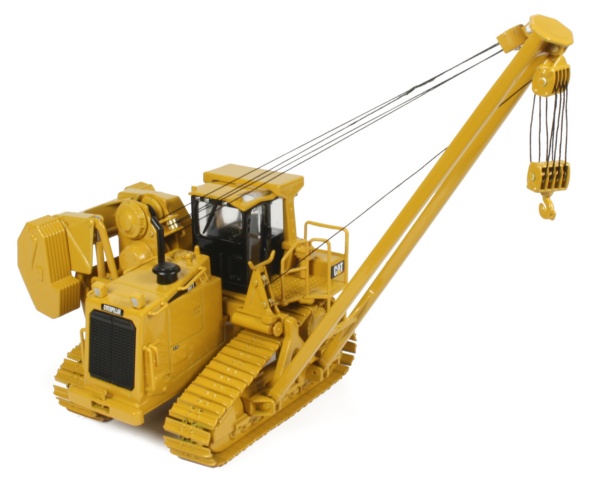
Caterpillar 587T Pipe Layer

Presented here is the 1:50th scale Caterpillar 587T pipe layer from Norscot. When the model was first announced, I was a little surprised as CCM had already produced a die-cast version of the model, especially as Norscot released an image of the open cab version of the machine. I have to say that now the model has been released, it features a fully enclosed cab making it different from the CCM version.

While a Norscot model is never going to be as highly detailed as a CCM piece, I have to admit that Norscot have given it a go and there are some very nice details on the model, as well as a cockup with the winch functionality but more about that later.

The metal tracks are individually linked with working spring tensioning of the idler wheel to keep the tracks tight to the frames. The track frame itself has the bottom roller detailing cast into the surface rather that having actual rollers however it does not look at all bad.

The side mounted counterweight can be extended outwards which gives better stability and also gives access to the winches which are covered when the weights are up against the chassis. The single piece castings do have ridges to highlight the individual plates that are fitted to the full sized machine although there are no printed safety chevrons on the couterweight which makes them look a little bare.

When fully retracted, the contour of the counterweight fits snugly alongside the tracks reducing the width of the tractor and this functions well. The rear fuel tank appears to be plastic which is a little strange considering the rest of the rear chassis is metal.

Access to the cab area is by the accurately scaled access ladder and steps fitted to the track frame, complete with plastic grab rails and this adds to the realism of the model. The rear of the model features a non functional towing hitch.

The fully enclosed cab that is fitted to the model is a very welcome addition, complete with roof mounted window allowing the driver to see the boom tip. Front and rear facing work lights are integrated into the roof with windscreen wipers and ROPs frame added. The platform outside the cab has a textured anti-slip surface with the rope guide assembly mounted just in front of the cab. The pulleys are metal which is a nice addition and all pins have been touched up with paint.

The front grill has an intricate ridged pattern cast into it which looks good, complete with dimples simulating the fixing bolts. The front bumper has an integrated towing bar with a number of scaled grab rails on both sides of the engine bay with work lights mounted to the top of the engine compartment.

On first examination, the method of connecting the rope to the boom and hook block appeared to be totally incorrect, potentially ruining a fantastic looking model. The operation of the winches is the most important part of a pipe layer and so should be fully functional.
Out of the box, there is only one piece of rope which is connected to the upper winch which does actually rotate, allowing the boom to be raised and lowered. Unfortunately, this rope also loops around the lower winch and through the hook block so the hook cannot be operated seperately. To lower the hook, as pictured below, you first have to lower the boom and then, while holding the hook, lift up the boom, manipulating the rope through the hook block. This is far from ideal and a compromise on Norscot's behalf which is very dissapointing.

That said, the casting of the boom pulley block fixed to the winch housing does have a tie off point on it. As both winches do actually rotate, it is possible for the collector to get the model functioning as the full sized machine does, so the hook and boom operate independently. To do this, all you need is a length of accurately scaled rope.
Firstly, wind in all the rope onto the top winch, cut off the hook block and tie the end of the rope to the pulley block at the base of the winch housing. This then gives full operation of the boom from the top winch. Taking more rope, attach it to the bottom winch and wind plenty on. This rope can then be threaded through the pulleys to re-reeve the hook block. Once finished, the model can be operated correctly with the top winch operating the boom and the bottom winch operating the hook block. Why Norscot cannot have done this at the factory is a mystery.
In my opinion, Norscot have done a fine job on the model with plenty of detail coupled with a good paint finish. With the winch issue aside, this is a great addition to the Cat model range and reasonably priced.
